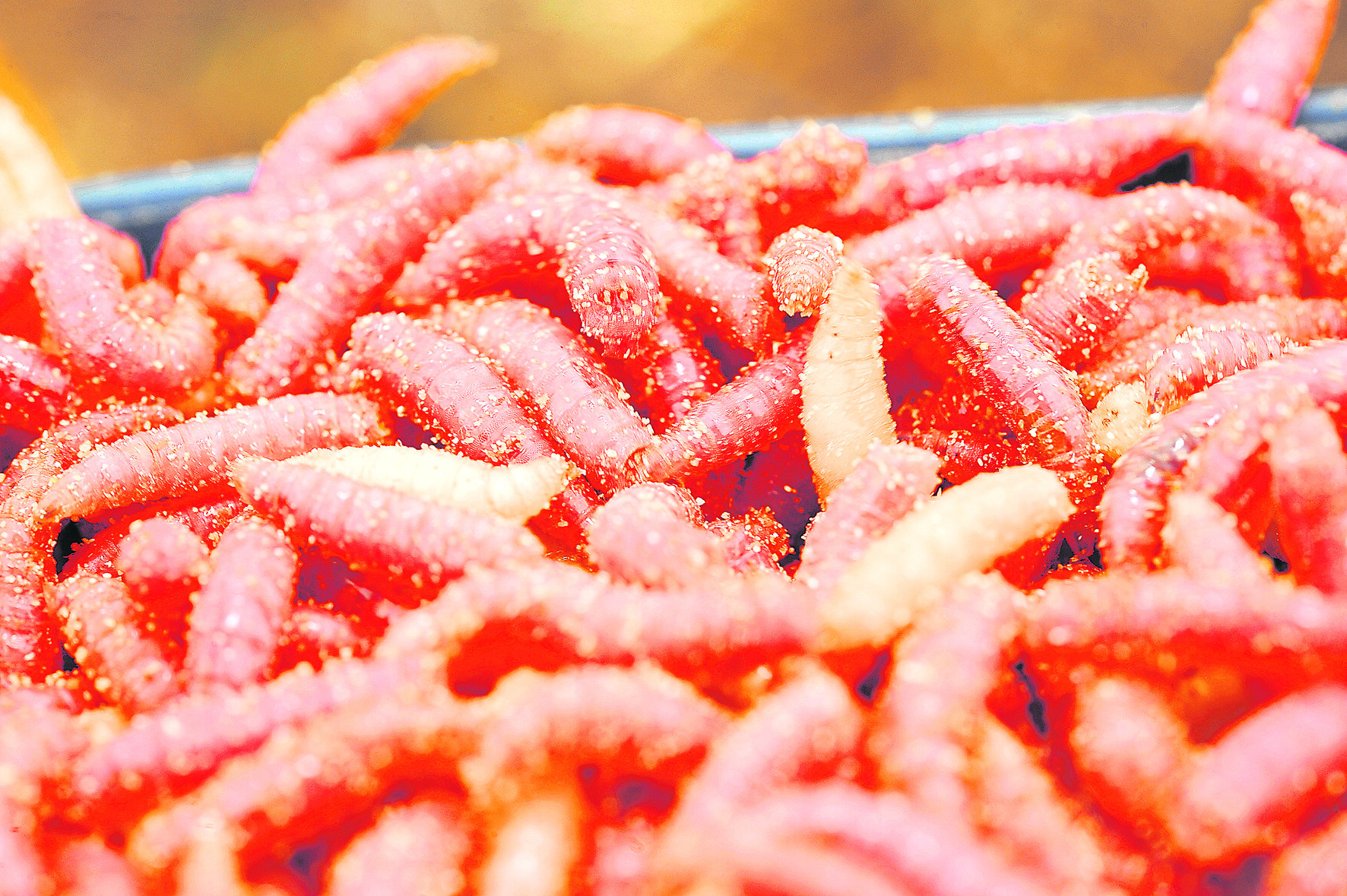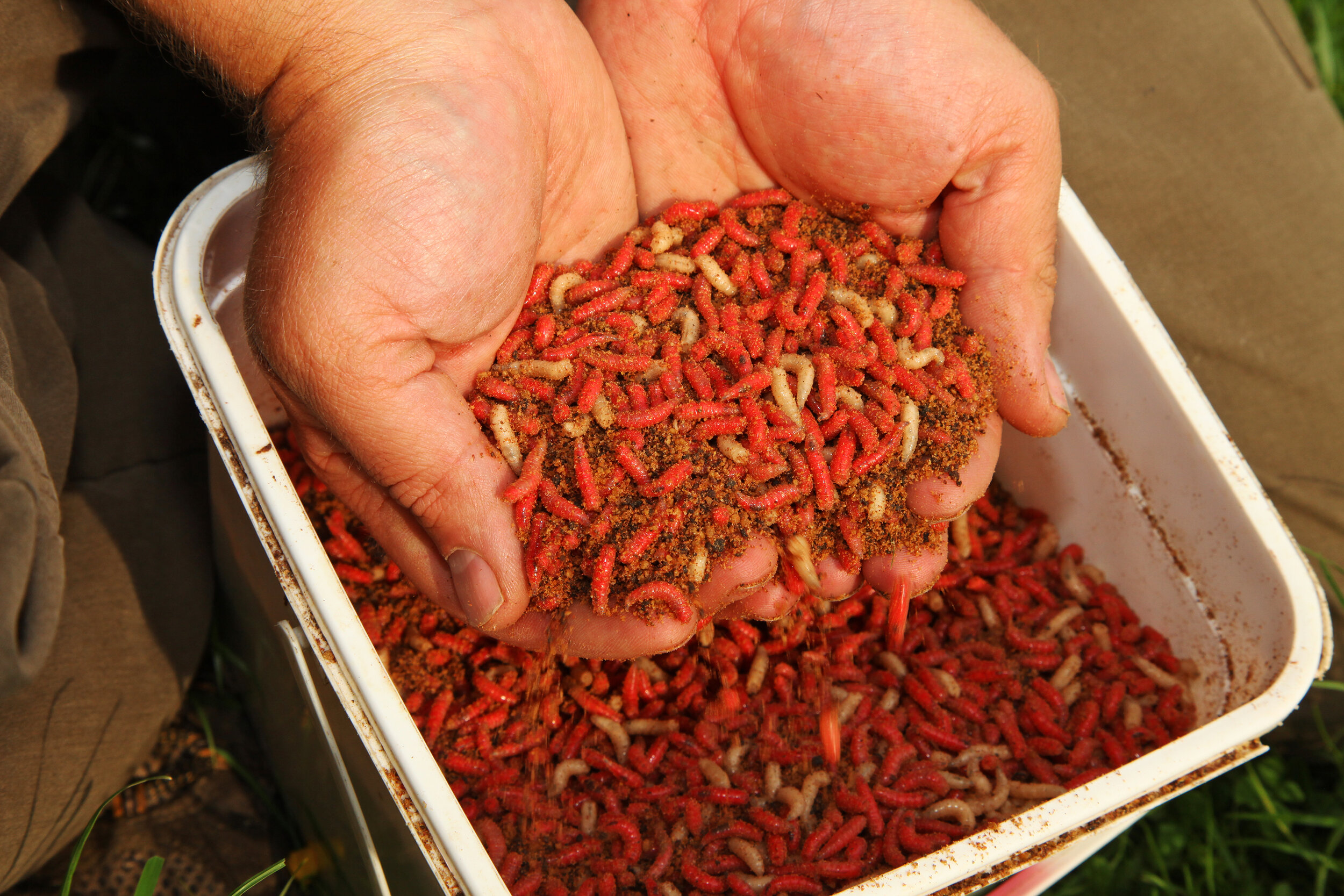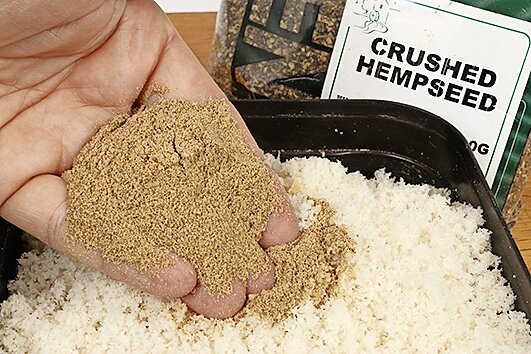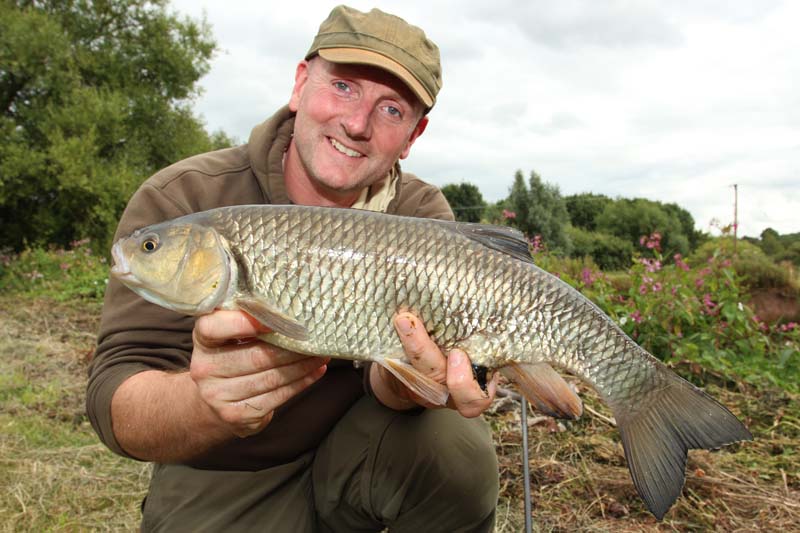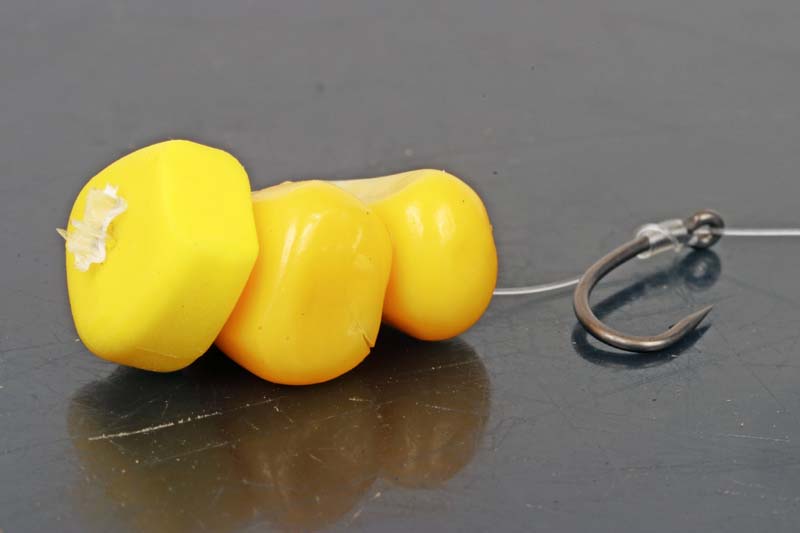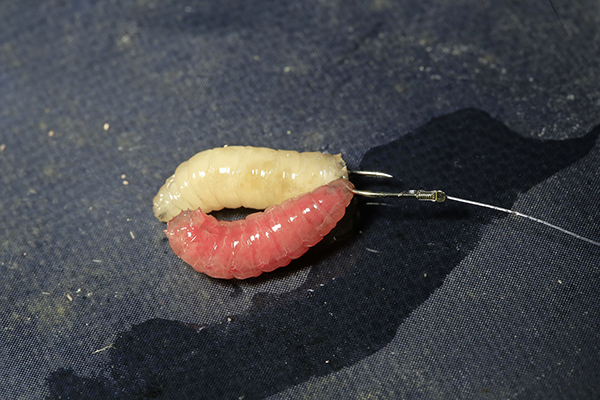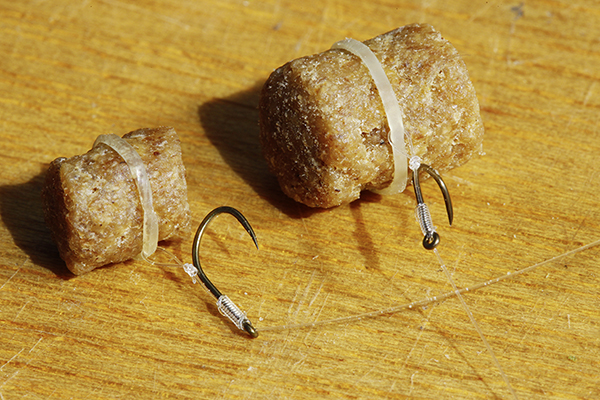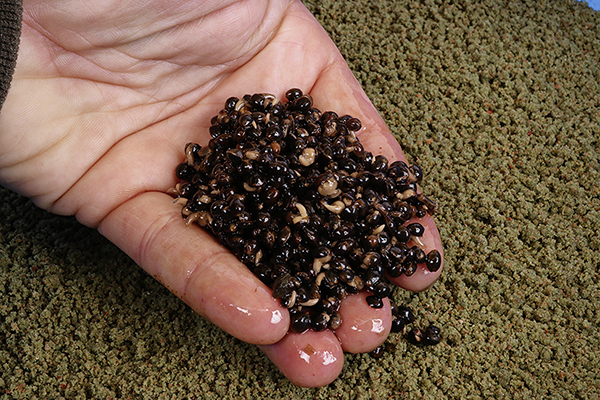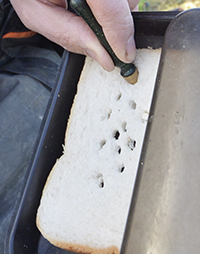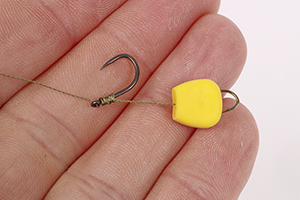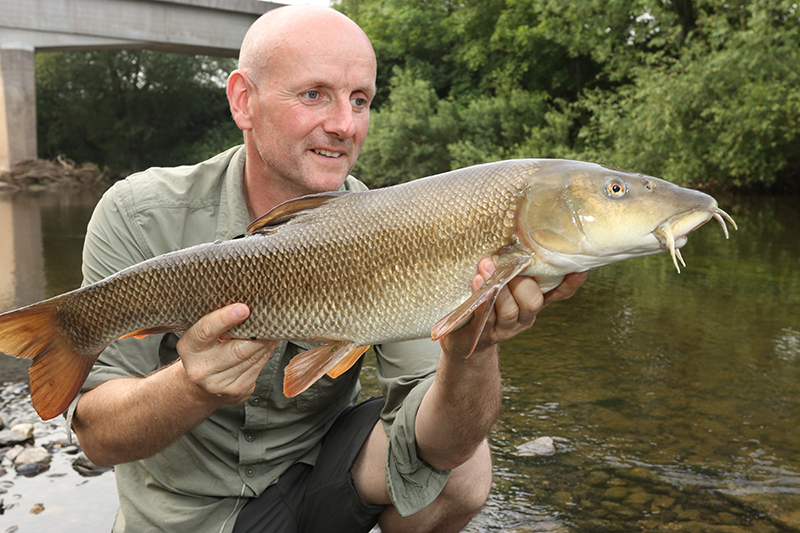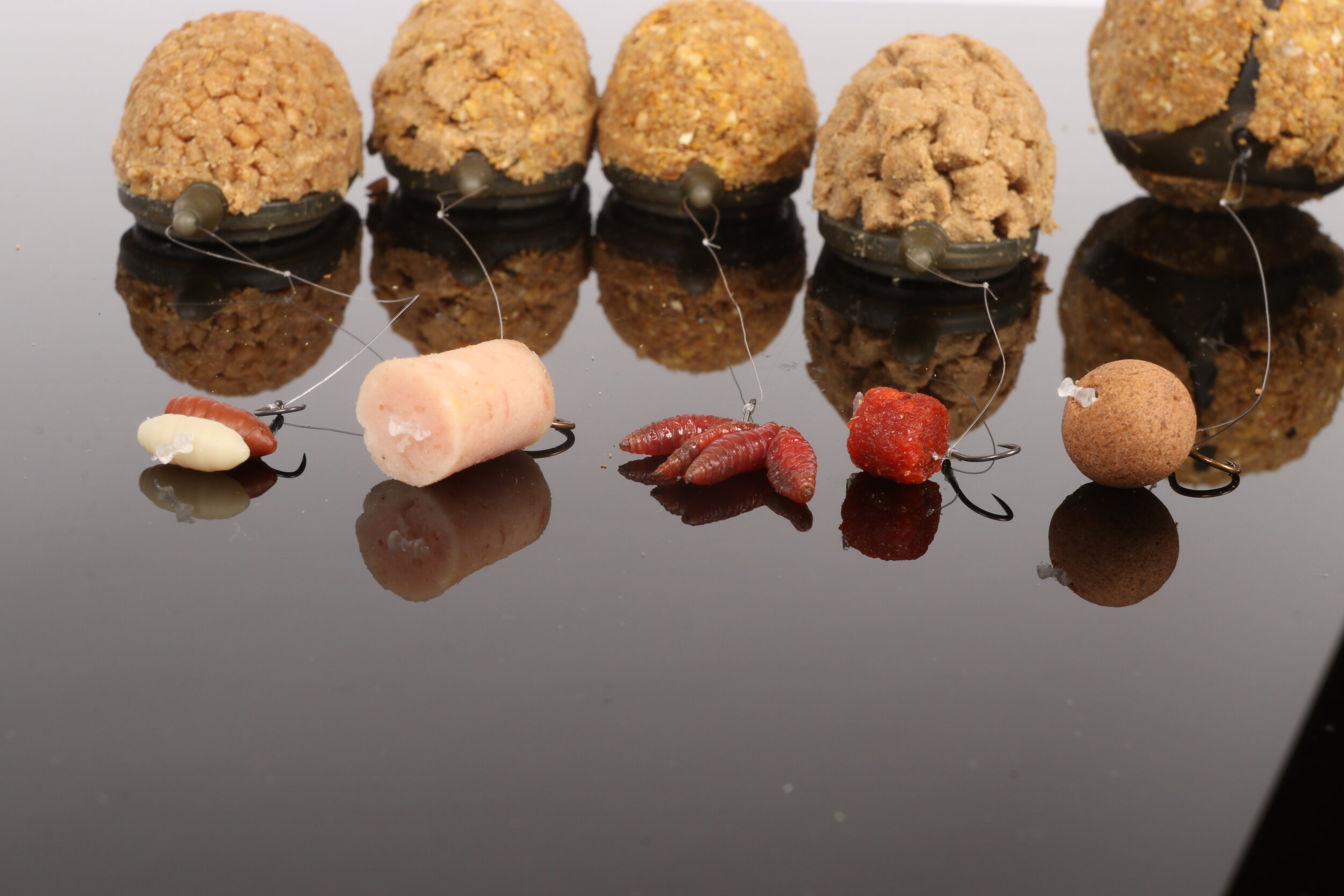What's the best all-round maggot colour? - Bob Nudd
I’d take the colour of the water into account because when there’s a brown tinge to the water, bronze maggots work really well for roach, dace and chub especially on waggler or stick float tactics.
My favourite all-round colour is the red maggot, and that’s because I think that they look like a bloodworm, which is the natural diet of many fish.
It’s also worth using a fluorescent pink maggot as a change bait, as again, the colour really stands out.
For more of your angling questions answered, turn to our ‘Ask The Experts’ section of the magazine each Tuesday.
"It has to be bread for river roach" with Dr Paul Garner
Roach are staging a substantial comeback. Whether from the tremendous work of the Avon Roach Project, or natural recruitment on other rivers, big roach are out there for those willing to look for them.
Very often the first clues are fish caught by accident, often by chub or barbel anglers, using heavy gear. Be quick to follow up on these leads and you might just strike the silver fish mother lode.
WORLDS APART
Quite why river roach should be willing to feed on a much wider range of baits than their stillwater cousins, especially in the winter, can only be guessed at. I think it is probably because in stillwaters small invertebrates make up virtually all of the fish’s diet. This means that they become fixated on small baits, such as maggots.
In rivers, big roach will have a wider natural diet, and so are not as choosy. Heavily-fished carp lakes are almost a halfway house, with large volumes of boilies, sweetcorn and pellets going in to supplement the roach diet. Yet, even here, the number of big roach caught on these baits can be minuscule, especially in winter.
PUNCH IT
I grew up among an older generation of dyed-in-the-wool roach anglers whose tactics are just as good today as they were back then. Bread was their bait of choice, normally fished under a big balsa float to hold the line when trotting downstream. Today we might prefer to quivertip with a small feeder, but the bait choice remains the same
A decent-sized piece of bread can be a very selective bait, picking out the bigger fish.
A punch of around 8mm is perfect for producing big-roach hookbaits, although you must get the texture right to keep the bread on the hook. Look for a thick-sliced white loaf with a dense structure. Cheaper loaves tend to be full of air pockets that lead to their falling to bits.
To toughen up your slices of bread, compress them overnight. I use an offcut of kitchen worktop heavy enough to halve the thickness of the slices overnight.
Place a damp cloth between the bread and the weight to stop it sticking and to add a little moisture. Store the slices of bread in an airtight bag to stop them drying out.
TRY A CAGE
A small cage feeder is an easy way of feeding bread. A dry mix will hold in the feeder, but break down quickly. Drop your feeder into a bait tub of water to see how long it takes to break down.
CLOUDY FEED
Whether I am floatfishing or feeder fishing, my feed is based on punch crumb. This very fine white crumb is much less sticky than normal white breadcrumb and has an almost gritty texture. Mixed dry it will form an excellent cloud in the water column, but add a tiny bit more water and it will hold together and sink quickly.
Alternatively, remove the crusts from a few slices and put the white flake through a food liquidiser until it has been ground to a fine consistency.
This liquidised bread holds together perfectly in a cage feeder, and can be added to punch crumb when floatfishing to help get it down.
Roach don’t have big appetites, so avoid adding any larger pieces of bread to the feed. Two ingredients that are worth adding are a pinch of crushed hemp and the same of crushed pellets. Using pellets for river roach may seem odd, but roach do like the taste of pellets, even in rivers where they aren’t used a great deal.
MY CAGE FEEDER MIX
A combination of liquidised flake and punch crumb makes the ideal feed for a cage feeder.
Here is how I make mine...
Remove the crusts from six slices of white bread and break them into pieces.
Use a liquidiser to reduce the flake to fine particles. Make sure that you remove as many lumps as possible.
Add a small amount of crushed hemp and pellet powder to two pints of liquidised bread.
Use an atomiser to very lightly wet the mix to help it bind together.
Add a small amount of punch crumb if a stiffer mix is required.
***FOR MORE GREAT BAIT TIPS FROM PAUL, PICK UP THE MAGAZINE OUT EVERY TUESDAY***
Boost your groundbait and catch more river bream
At this time of year, even a single day of rain is enough to send river levels up and add colour to the water. When that happens, bream become a reliable target.
Spurred into feeding by this influx of water and reduced visibility, these fish can appear after months of absence. In mild weather, 100lb is possible when you land on a hungry shoal on slow-flowing venues – but it’s far from a case of simply throwing a feeder out and bagging!
We asked England international and former FeederMasters champ Darren Cox for his tips on river bream succes in these conditions.
Choose your peg
“The first consideration is where in the peg to fish. I look for any large areas of slack water, whether thaey are caused by a bay or water running off a bend.
“The point where a river opens out from narrows is another guaranteed bream area. They love slower water, as not only is there reduced pace but natural food and silt will gather, resulting in a big larder for them to get stuck into.
“The silt will be full of bloodworm and the bream won’t move far from here. To find a silty bottom, cast a feeder or bomb out and wind it slowly back across the river bed. Resistance as the lead digs into the silt tells you you’ve found what you’re looking for.”
Add some fishmeal
“With colour in the water, bream feed by scent, not sight, so a groundbait to go in the feeder needs something powerful to stop them – that means fishmeal. I’ll mix up a ‘normal’ bream blend of sweet groundbait but also add a good helping of a halibut or plain pellet-based mix. This is mixed fairly dry to empty out quickly.”
Feed and hookbaits
“Keeping with the positive theme, I try and cram each feederful with as many particles as I can. That’s casters, chopped worm and dead maggots lacing the groundbait, because a big bream can demolish a feeder of bait in one go. Imagine this happening with a dozen fish in the area and you can see how much feed needs to go in.
“For the hook, nothing can beat worms on a coloured river, and while a dendra or lobworm tail is good, I swear by two large redworms tipped with a dead red maggot. Redworms wriggle like mad, and a bream can pick them out far quicker than three dead maggots, for example.”
Keep the bait going in
“I’ll cast every five minutes, even if I’m not getting bites to keep the bait going in on a regular basis – you have to be positive. Clipping up and aiming to a far-bank marker will put the feeder in the right place each time.
“If I cast and immediately get a knock on the tip this tells me that the fish are not backing off and that they want the feed, so you need to try and read the timing of the bite. If I am left waiting five minutes for an indication then the fish could be backing off.”
The feeder is king
“Rod and line is the only option for tackling a slack at range – the waggler just won’t present the bait still enough. That means it’ll be an out-and-out feeder job. Rigs for a slow river are nothing special, made up of the feeder running on the mainline that has a short 4ins twizzled length above the hooklink, for a semi-bolt rig effect.
“Mainline of 6lb is perfect, with a 30g wire cage feeder heavy enough to hold bottom in the slower water. A hooklink of 2ft 6ins or 3ft made up of 0.16mm Garbo Line will put the bait well downstream of the feeder, which is where you often find bigger bream sat below the feed picking off particles. That only leaves the hook to pick, and I can’t fault a size 13 Kamasan B711.”
Kicking off
“Six feeders of bait go in at the start and I would expect indications quickly. If nothing happens after half-an-hour but I am getting small fish knocks, this tells me more bait needs to go in so out go another six feederfuls.
“If nothing is happening at all then it will be a bit of a waiting game so you’ll need to leave the feeder out for longer and wait. Provided you are on a bream peg and conditions are right, there’s no reason why they won’t feed.”
Top Five Roach fishing baits to try now!
What is the best bait to use when roach fishing? Well we are about to answer that for you and give you five great roach fishing bait options for you to try next time you’re on the bank.
Here are five of the best roach fishing baits…
For more great tips from top anglers head to this year’s The Big One Show
• Maggots
I have often noticed that smaller silver fish tend to become a lot less active at this time of year, owing to the low water temperature, while the larger fish remain active. This can make maggots a viable bait.
Ask your local tackle shop on what day they receive their maggot supplies, and try to buy your bait as soon as it comes in. This will ensure you get the freshest and largest maggots. To keep the skins soft I store them in maize flour, changed every few days to keep it fresh.
Pineapple essence is the quintessential winter roach flavour, and its highly volatile esters leak off even when the water is very cold. Other citrus flavours are well worth using too, but there’s no substitute for fresh bait, especially where big winter roach are concerned.
• Pellets
Our barbel rivers see large amounts of pellets going in all summer and autumn, and naturally roach tune in to this extra food resource. Fishmeal is a good fish attractor, even though we don’t normally associate it with roach. Try mixing some ground pellets with your liquidised bread and you’ll see what I mean.
For roach, try scaling everything right down to a 6mm tough hooker pellet fished on a bait spike and size 16 hook. Fill a Black Cap feeder with hemp and hard pellets. Don’t worry about the water temperature – roach will still eat pellets in the depths of winter, so I plan to use this tactic a lot this year.
• Hemp
When I have filmed roach underwater no other bait has attracted and held them in the swim like hemp, yet they often pick it up and blow it out many times before eating it.
For this reason I tend to feed the seed sparingly. A tin of hemp is generally enough for a day session. Feed it a pinch at a time to maintain a continual release of hemp flavour into the swim, rather than have it slowly dwindle away.
I don’t often fish hemp on the hook, but I will combine it with my other four baits. Hemp and pellet is a modern classic, in my book, and well worth trying, especially on barbel rivers.
• Boilies
As with pellets and hemp, roach see a lot of boilies as a by-product of carp and barbel anglers’ feed. Some of the biggest winter roach are caught by carp anglers on boilies, and this is a very effective way of singling out the bigger fish.
A 10mm boilie is just about the right size for a 2lb roach, and I can think of a number of times that this bait, along with a small PVA stick of pellets, has allowed me to get through the small fish and select just the big ones from the shoal.
• Bread
There is no better bait for roach than bread. Very cheap, it selected big fish from rivers and lakes where we never dreamed the roach grew so large. Knowledge of how to get the best from bread is slowly ebbing away, but that doesn’t make it any less effective, just unfashionable.
Back in the day I’d use heavy trotting gear with an 8mm disc of punched bread on the hook. A nugget of liquidised bread fed every cast would be all the feed that was required.
I am sure these tactics would still work just as well today and I plan to try them again soon, especially on running waters, where a bright, obvious bait would be difficult for any big roach to ignore.
Chub Fishing Baits | Best baits for big chub
We asked bait expert Paul Garner what his best baits to go chub fishing with were and he came back with five amazing chub baits that will make sure you land your biggest ever chub on your next session.
The scorching weather of the past few weeks has had a big impact on my river fishing so far this season.
For more great tips from top anglers head to this year’s The Big One Show
With barbel off the menu, I have spent some enjoyable evenings stalking chub on my local rivers instead. The low, clear water conditions have been perfect for this, with the dark shadows lurking under the overhanging branches of bankside trees giving away the presence of my quarry.
Location is rarely a problem with chub – you know they are never going to be far away from cover at any time of the year, and a good flow will attract them too, even if the water is only knee-deep. Persuading them to take a bait can be a different proposition, though, especially if they have been fished for, as their superb eyesight and uncanny ability to spot anything out of the ordinary can make them frustratingly difficult to catch.
With time, and a steady supply of maggots or casters, you can overcome this natural caution and often catch most of the fish in a shoal, but I prefer to roam the river, looking for fish and making just a cast or two in any likely-looking spots before moving on to pastures new.
Fishing like this, especially if you can follow the path of the bait and the reaction of the fish, can teach you a lot about the behaviour of the wily chub in your local river.
Choice of bait is important, and although I will normally only carry one or two types with me at any one time, there are five that stand out as the best for summer chubbing.
SLUGS
Not for the squeamish, but by far the most effective chub bait that I have ever used, slugs elicit an instant reaction from chub that has to be seen to believed.
The loud ‘plop’ of a slug hitting the water will attract any chub in the swim and within seconds those white rubbery lips will engulf a freelined bait. If you don’t get a bite on a slug then you can be pretty sure that there are no chub in the swim!
While my garden is full of slugs in the spring, hot weather can make them difficult to find, just when you need them most.
Look in any dark corners of the garden, especially first thing in the morning. Compost containers are often home to loads of slugs and are the ideal places fom which to collect them. There are several different species, and the chub love them all! Store your slugs in a cool, dark spot and they will last for several days.
WORMS
When I find it impossible to collect slugs my second choice, although it can be hit-and-miss, is worms. You won’t find a worm that is too big for a chub, so go for the largest you can find, as this will add casting weight.
The bigger the worm, the more it can resist the attentions of small fish. Just as with slugs, you are likely to get a bite on the first or second cast as the chub home in on the splash. If no reaction is forthcoming it’s best to move to a new spot and try again.
Hooked once through the ‘saddle’, worms will last for several casts if they aren’t gobbled up first. Although not as dense as slugs, worms can still be lobbed a reasonable distance without any additional weight needing to be added.
LUNCHEON MEAT
I always keep a couple of tins of meat in the car. Although not the most effective chub bait, a cube of meat can save the day when other baits are hard to come by. I treat meat just as I do slugs, hooking a large cube on to a size 8 hook and freelining it into any likely-looking spot. One benefit of meat is that its light colour is very easy to follow as it slowly sinks and drifts downstream.
Often, the bait will simply disappear as a chub swallows it.
BREAD CRUST
On larger rivers it can be difficult to spot chub, especially if they are holding station in mid-river. In this situation you can still freeline a bait and simply watch the line for bites, but often a different approach is more effective.
On hot, windless evenings chub will often take emerging insects off the surface and we can make use of this behaviour to catch them. The crusts of a fresh loaf make the ideal bait, pulled into chunks and allowed to drift downstream. Pay particular attention to crease lines, where chub are likely to hold station.
Follow the crusts downstream until you spot the tell-tale splashes of chub picking them off. Once the chub are feeding confidently like this the hookbait is likely to be taken straight away.
TINY LURES
For sheer fun and excitement, few methods beat light lure fishing for chub. A splashy lure fished on or just beneath the surface will often bring a response. Try fishing really shallow swims where the broken water gives way to a steady glide. Often chub will be here feeding on minnows and other small fish.
Alternatively, try using more imitative lures – grasshoppers, crayfish and tiny fish patterns – that can be mounted on a 3g jig head and bounced across the bottom of shallow swims.
Expect the unexpected, and don’t be surprised if this tactic catches other species too.
Five amazing baits for summer bream
Want to land a big net of specimen bream this summer? Then check out these great bait tips for bream from bait expert Paul Garner as he has put together the ultimate list of bream baits to help you catch more now.
For more great tips from top anglers head to this year’s The Big One Show
Every summer I try to put together a good catch of bream.
This could come from a river or a stillwater, as both types of venue can contain shoals of slabs averaging 5lb and upwards.
My tactics are simple, but effective. The Method feeder is my first choice, loaded with a groundbait mix that won’t break the bank.
A lot of rubbish gets talked about how much bait you need to catch bream. Sure, a shoal can number dozens, if not hundreds, of fish, but remember – you are trying to catch them, not feed them! My experience is that heavy baiting for bream can be counter-productive.
If the fish are following a patrol route then no amount of bait will persuade them to stop. Introduce too much and they will leave most of it, including your hookbait.
A couple of kilos of bait is more than adequate for a day or night session. The bulk of this will be groundbait, with a tin of sweetcorn and some pellets and mini-boilies thrown in for good measure. If I have some frozen maggots in the freezer they will go in too, but they are just the cherry on the cake and not essential.
CHEAP GROUNDBAIT MIXES
Bream do love fishmeal groundbaits, and a mix that contains plenty of crushed pellets will certainly do the trick.
It’s surprising how little fishmeal is needed in the mix to have an effect, though, so to cut costs I will use a 50-50 combination of groundbait and brown crumb, to bulk out the bait. Remember, though, that brown crumb does not bind particularly well, so this could well affect how much feed the groundbait can hold.
I use soaked flaked maize a lot. This resembles cornflakes in its dry state, because that is essentially what it is! When soaked it swells up and emits a milky haze with soft flakes that bream (and carp) really like.
I use molasses to flavour and sweeten the groundbait – I find it to be most effective for bream, and it’s cheap. You can buy it by the litre from animal feed shops.
Sweetcorn
Bream love corn. Its yellow colour and salty taste make it easy for them to locate and they will spend a lot of time eating every grain. This makes it a top hookbait too and I normally use two or three grains on a hair to make the hookbait stand out. Because this is a relatively soft bait, look for grains that are fully intact. Try combining two pieces of real corn with a buoyant flake bait to produce a brilliant wafter.
Mini-boilies
If I am night fishing then 12mm boilies will often be my hookbait of choice, simply because they are long-lasting and I can have total confidence that they will still be there come morning. For bream up to about 8lb I use a single 12mm bait, but for bigger specimens I find two 12mm baits brings more bites. Try a sweet flavour, such as Strawberry Crush.
Dead maggots
Live maggots can attract too much attention from small fish, even though they are a brilliant day-time bait. Switching to dead maggots both in your feed and on the hook can avoid this problem, as their lack of movement doesn’t attract as many small nuisance tiddlers. Try using a bunch of four maggots on a size 14 hook for best results.
Worms
Worms can be problematic if you are on a venue with a lot of small fish, but on a
low-stocked pit they can be very effective. Try to get hold of some small lobworms – no more than 4ins long. I like to hair-rig these, adding a piece of buoyant corn to not only give the bait some buoyancy, but also to act as a giant bait stop.
Pellets
Bream love pellets, especially high-oil halibut pellets, and two 10mm baits hair-rigged in tandem have caught me a lot of big bream. You can buy ready-drilled baits that are very easy to rig, but the hole can be a little too large for a normal bait stop. Try using a Quick Stop, or add a tiny square of elastic band before the stop.
How to prepare sticky micro pellets
Micro pellets need to be prepared quite differently to normal fishery pellets. Instead of soaking them it is much better to very slowly add water directly to the pellets, just as you would if mixing groundbait. This stops them breaking down and turning into concrete!
For more great tips from top anglers head to this year’s The Big One Show
1) Add a good glug of Scopex Squid Syrup to a pint of water and stir well until the syrup has dispersed.
2) Mix a handful of 3mm pellets with a bagful of sticky micro pellets and put the pellets into a shallow mixing bowl.
3) Slowly add the liquid while keeping the pellets moving all the time. Only add more water once the initial liquid has been absorbed.
4) When the pellets have reached the right consistency they should stick together when compressed in your hand, but break down to a mush when rubbed.
Tench fishing baits | How to make Jelly pellets
Summer is here which means it is a perfect time to go out tench fishing. However finding the right bait to use can be quite difficult which is why we've asked bait expert Paul Garner to walk us through this great tench fishing bait so you can try it out at home.
Pumped expander pellets are ideal for tench and crucians, giving that key soft texture that is so important.
Adding a small amount of gelatine to the water gives the soft pellets a more robust texture, meaning they will stay on the hook better.
For more great tips from top anglers head to this year’s The Big One Show
1) Add a teaspoonful of Scopex No1 flavouring and a similar amount of red powdered dye to a pint of warm water.
2) Add a sachet of gelatine powder to the warm water and stir constantly until the gelatine crystals have fully dissolved.
3) Half-fill your pellet pump with 6mm expander pellets and then pour the dyed and flavoured liquid over them.
4) Pump the pellets then leave them to stand under pressure for about six minutes, or until they have all sunk, whichever is the sooner.
5) Release the pressure and pour off the excess liquid. The pellets will still be quite hard, but will soften as they absorb more liquid.
6) Store the pellets in an airtight container. A tablespoonful of squid powder coats the pellets, giving them even more attraction.
Spend less and catch more with this method mix!
Want to catch more carp while fishing? then take a look at this amazing carp fishing method mix from Angling Times columnist and Nash backed Paul Garner. We asked Paul to give us his best carp fishing bait on a budget and he came back with this golden piece of information.
Rather than use a Method mix that breaks down quickly, I much prefer a slower release of bait from the open frame of the flatbed feeder.
This ensures that the the bait on the feeder will remain the focus for the carp even when their frantic grubbing around on the bottom, complete with waving tails, is washing the pellets all over the swim.
To get this slower release effect is simple – I mix a small amount of groundbait in with the soaked pellets, as here...
1) Cover a pint of 4mm coarse fishery pellets with water and let them stand for four minutes to absorb some of the water.
Pour off the excess water and allow the pellets to stand for a few minutes more until they are soft all the way through.
Add just a sprinkling of Method groundbait to the pellets and mix well so that the dry groundbait evenly coats the pellets.
Use a Method mould to firmly press the pellets on to the feeder in the usual manner.
Leave the hookbait just outside the feeder so that it is not obstructed by the pellet feed.
Best commercial fishing baits for carp
Commercial carp can be caught on sorts of bait, to help you narrow your options down next time you are on the bank we've decided to put together this handy little guide to some of the best baits to catch commercial carp on.
For more great tips from top anglers head to this year’s The Big One Show
Double maggot
In cooler weather double maggot will often pick out the better-sized fish. Most top match anglers will fish with one red and one white maggot, as this seems to appeal to F1s more than two of the same colour – crazy but true!
Caster & worm combo
Caster make a fish-attracting noise as they hit the surface and F1s love eating them! However, fishing casters on the hook can result in missed bites and smashed baits. Try a caster-sized piece of worm segment to get around this.
Hard pellets
F1 carp are reared on pellets and love eating them. The 4mm and 6mm sizes are best for this small-mouthed fish. To fish a hard pellet as a hookbait you need to hair-rig a small bait band.
Expander pellets
On lakes with few silverfish, soft expanders are brilliant for F1s. Lift and drop the rig for a rise and fall of the bait. Most anglers use 4mm pellets in winter and 6mm in summer, fed little and often.
Sweetcorn
Most fish like to eat corn, F1s included. In clear water a grain of sweetcorn stands out a mile and it’s also a brilliant bait to fish on a margin rig down the edge. Get a tin which has mixed sizes as you’ll find the smaller grains best for F1s.
Breadpunch
A great bait in colder weather, F1s are suckers for a bit of punch and this hookbait will often get you a fast start to your session if you can drop a small, 6mm disc close to far-bank rushes or features such as aerators.
10 of the best tench fishing tips and baits
Spring is here and so are the tench! We've decided to compile together 10 of the best tench fishing tips and ait for you to use on your spring and summer campaigns for this great species. To help us put together these great tench fishing baits we asked bait expert Paul Garner to give us some of his favourite tench baits.
From floatfishing in the margins, to long-range feeder fishing, the tench angler has to master many different methods, and learn how to get the best from the available baits.
My tench fishing evolves over the coming weeks as the fish change their behaviour, but there are some tactics that come into play each season for me and which have stood the test of time. Let me share them with you...
1) shellfish maggots
Maggots often figure very highly in my tench fishing.
Being easier to store than casters, maggots are a convenient choice that have caught me tench on every venue where I have tried them. I always use the freshest and cleanest maggots that I can buy. Every few days I change the maize flour that I store them in, as this does become sour, even if the maggots sweat.
There is one additive that I always use on my maggots when tench fishing, and that is Shellfish Sense Appeal. Just a few drops of this smelly shellfish extract added to a pint of maggots will have a big impact on my catches, and I never leave home without it.
2) Yellow pop-ups
When tench are just getting going in the spring, a highly visible bait often scores really well.
I noticed a few years ago that carp anglers tend to catch tench at this time of year on their chod rigs, especially when using small yellow baits. Following suit with a scaled-down approach, I found myself catching loads of tench on 10mm pop-ups fished on a mini chod rig.
I think that any tench that is cruising past can spot the yellow hookbait very easily, and more often than not will eat it. Don’t expect this tactic to last for very long, though. For some reason it loses its effectiveness by the middle of May.
3) hemp as a holding bait
Hemp is a great bait for attracting and holding tench, but I am not convinced that they actually eat much of it.
Underwater filming has shown that tench often pick up hemp but then blow it back out again, rather than swallowing it.
This has certainly influenced how much hemp I introduce, and now I rarely use more than a pint per day. I like to introduce this on a little and often basis, keeping that lovely nutty smell topped up, but not introducing too much bait.
4) Cocktail Baits
You can often get extra bites by combining two tench baits on the hook, especially if you have both baits in your loosefeed.
Try a combination of worm and caster, or maggot and corn, to produce a bait with some movement and more bulk than either bait on its own.
5) Sweetcorn
At one time sweetcorn was talked about in hushed tones, so effective was it as a tench bait, but in recent years it has certainly fallen out of favour with many tench anglers.
This is a shame, as it is still a fantastic bait and if it hasn’t been used heavily on a venue it will often work really well. Carp anglers often introduce lots of corn in their spod mixes, yet never use it on the hook, so they are effectively prebaiting for you!
I normally use two grains on the hook when floatfishing to create a nice visible bait. If you are legering, try a combination of one real and one fake piece of corn.
A small tin of corn is more than enough for a tench session. Try feeding six grains after every bite to keep the fish interested.
6) worm rigs
Worms can be quite difficult to fish with, especially if you are legering, as they have a tendency to work their way off the hook.
Overcome this by tying up a hair rig with a rubber caster and a Quickstop on the loop in the hair.
Push the Quicsktop through the worm leaving it fixed between the stop and the rubber caster, and it will not be able to escape. Use a short hair so that the worm is just below the bend of the hook.
The caster not only adds a small amount of buoyancy, but also stops the worm wrapping itself around the hook.
7) krill groundbait
Most anglers wouldn’t associate tench fishing with using groundbait, but a few years ago now I stumbled across a great combination that works very well in both a cage and Method feeder – and the tench love it!
I use a 50-50 mix of Dynamite Swim Stim Green groundbait and Krill Meal, and have found this to be supremely effective. Be careful not to over-wet this mix. It needs to be mixed slowly, so that the water is fully absorbed, until you are left with a fluffy texture that binds together quite well.
The Krill Meal is quite expensive, but fortunately you do not need a lot of this groundbait as I use it purely on the feeder – so half-a-bag is plenty for a day session.
8) Casters
Casters are a very effective tench bait. I use them on venues where small fish make using maggots difficult. This is not because they are second-best, but because maggots are easier to store both on and off the bank.
Try using two parts casters to one of hemp to keep tench grubbing away all day. There is no need to use real casters on the hook – although you can if you want to – but rubber casters are just as effective and far easier to use. Store casters in the fridge, in an open container so that they can breathe and stay slightly damp.
9) Fantastic plastic
Whether it is a bunch of rubber casters, a piece of fake corn, or a plastic pop-up boilie, tench will readily take artificial baits, and so often these can make the fishing so much easier.
I like to keep a range of different fake baits in my tackle box for occasions when small fish make using real baits difficult, or when I want to leave a bait out for several hours at a time.
Don’t worry that they have little natural smell – you can always try dipping plastic baits in additives, or fish them straight from the packet.
10) match the hatch
Very often tench can become harder to catch as the summer wears on. I think this is because their natural food become more abundant and they can pick and choose what they eat.
I tend to switch to smaller baits, such as maggots, by about June when the tench can be more picky.
It is also worth raking the swim lightly before fishing to disturb the natural insects on the bottom. This will draw in the tench and get them feeding hard.
How to make zig rig soup
With water temperatures starting to rise, it's time to start think about using zig rigs when you're next out on the bank. Here is a great recipe to help you lure those specimen carp to the upper water layers and help you catch on the zig next time you are on the bank.
Add a few handfuls of breakdown pellets to a tub of water and let them fully dissolve. The fine particles left are ideal for the soup, being neutrally buoyant.
To bulk out and increase the cloudiness of the mix you can add some maize flour. This will also save you a bit of money into the bargain.
Ground hemp is naturally buoyant, and carp love the taste of it, so it is an ideal ingredient to add. A handful is plenty, though, as it is quite expensive.
When well soaked, flaked maize sinks very slowly, so add a a handful to give the mix more food value – but make sure it is properly soaked so that it sinks.
Mix all the ingredients well and cover them with water. Leave the soup for as long as possible – for best results, overnight – to absorb all the water.
Add a tablespoonful of Plume Juice to the mix to flavour and colour it. I prefer sweet flavours in the spring, as the carp react very well to the sugary taste.
If the mix is a little watery, add just enough fine brown crumb to help it bind together. Bear in mind, though, that this is a ‘soup’ and should be quite runny.
The best way to fish with worms
Few baits are as attractive as worms, but unfortunately this can pose a problem if a lot of small fish are present. You can get through a lot of bait trying to feed off the tiddlers to get to the bigger fish, especially if you are feeding chopped worm. If this happens, try feeding whole worms, or chop them roughly to leave big chunks.
Feeding finely chopped worm can also be a problem, as the bait is very slow sinking.
A good way to overcomeg this is to feed the worm in a small amount of molehill soil, just enough to bind it together.
If you use groundbait then only add the chopped worm as and when you need it, because the salt in the feed will quickly dehydrate the worms.
I remove any soil from the worms by rinsing them in a maggot riddle before chopping. This makes them much easier to chop, and the cutter blades last longer.
Use a pair of choppy scissors to cut a handful of worms into bite-sized chunks. It’s well worth investing in a pair, which makes the job of chopping far quicker.
Add a handful of maggots to bulk out the feed. The colour is up to you, but reds are favoured by perch and skimmers, and stand out well in clear water.
Use a small bait dropper to introduce the bait, even on stillwaters, to ensure it all gets down to the bottom and doesn’t bring the fish up in the water.
Different types of worm
There are several different species of worm that you can buy or collect yourself for bait.
Some, like the lobworm, have been in use for thousands of years while others, such as dendrobaenas, are relative newcomers to the angling scene, and are easily farmed.
Lobworms
If you collect your worms from a lawn on a warm damp night, or put them to one side when digging the garden, then the chances are you are using proper lobworms.
Our native earthworm can grow up to 25cm in length and is probably the best worm hookbait that you can get.
I prefer to keep lobworms back for use as hookbaits only, and feed easy-to-come-by baits such as dendrobaenas or maggots.
Just about every fish that swims will eat a juicy lobworm, but they are especially favoured by perch and chub.
Dendrobaenas
Much smaller than a lobworm, dendras rarely measure more than about 12cm, and have less girth too. That said, their size and availability make them a great bait, both on the hook and as feed.
Because of their smaller size, dendrobaenas make a good bait for smaller species, and can be combined with maggot, caster, or corn to make excellent cocktail baits.
Redworms
Collected from well-rotted horse manure heaps – which sounds more unsavoury than it actually is – redworms are another small species of worm, but one that is very effective.
A favourite of the tench angler, a single redworm, or a worm tipped with corn, has resulted in the capture of a lot of big fish down the years.
Best bait for fishing in cold water
Are you struggling to catch in cold conditions? Well we got onto Guru backed Pemb Wrighting to tell us what bait is best to use when fishing in cold water. Take a look below at what he had to say.
Deadly bait
“Bread is absolutely brilliant in cold and clear water, and it is particularly effective when roach and skimmers are your target on lakes or canals.
“Its bright white colour means it stands out, and its lack of weight means it is easy for lethargic fish to suck up.
“Two loaves of bread are all you need for one session – the first has the crusts cut off and is put through a blender at home to create a fine loosefeed.
“The second is for the hookbait. I find that the cheapest loaf you can get your hands on is fine for the feed, using something a little tackier such as Warburton’s Toastie for the hook so that it stays on while shipping out and when waiting for a bite.”
Feeding regime
“A little-and-often feeding policy is usually adopted at this time of year, but when bread fishing is on the agenda things are a little different.
“I prefer to introduce a ball of bread the size of an orange at the start, and then only top up when the bites dry up.
“This concentrates the fish in one spot and they tend to remain over the top of the loosefeed until it has all been hoovered up.
“When bites slow down, introduce a nugget the size of a table tennis ball. The fish won’t be far away so not quite as much feed will kick-start things again.”
Delicate rigs
“Silver fish can be really finicky feeders, and if you use a float that isn’t dotted down enough or the tip is too thick you’ll miss an awful lot of bites.
“My favourite pattern for bread fishing is a Colmic Jolly. This has a rugby ball-shaped body, a carbon stem and a very fine tip. In water up to 4ft deep I will use a 4x12, stepping up to a 4x14 in anything deeper, or if it is windy.
“Light terminal tackle is also important and I use 0.11mm Guru N-Gauge mainline to a 0.08mm Guru Pure Fluorocarbon hooklength and a size 20 Guru Pole Special hook.
“These new hooks have the perfect shape for keeping 4mm punch on, and are extremely sharp, so you won’t lose any fish as you’re shipping in.”
Carp fishing with PVA bags
Using a PVA bag when carp fishing has become a very popular tactic for most carp angler's. However there are many ways in which PVA can be used when carp fishing below we will explain some of the best ways you can present your bait while fishing with PVA.
PVA (Poly-Vinyl Alcohol) is a water-soluble substance that can be made into solid sheets, tape and string, or woven to create a continuous mesh-type stocking.
Once in the water, the PVA will dissolve to leave a neat pile of freebies around your hook. Feed introduced in PVA traditionally needed to be completely dry, but ‘PVA-friendly’ oil-based liquids are now available, and won’t melt the PVA on the bank.
What to feed in PVA
The usual advice is to use only dry feed in PVA. However, ‘wet’ baits such as particles and nuts can be used if some dry groundbait, boilie base mix or salt is added.
Pellets are probably the most common filler for PVA bags and are first choice at this time of year.
Try using a brightly coloured pop-up boilie over the top of a small pile of PVA-introduced pellets and your chance of a carp will be good!
Another way to feed ‘wet’ baits is to coat the inside of a solid bag with an oil-based PVA-friendly liquid, then add the damp bait.
String
The traditional way to use PVA, but one that has gone out of fashion recently, PVA string is used to create a ‘stringer’. A number of baits – usually bottom bait boilies are threaded on to the string, which is then attached to your hook.
Rig foam
Although not made from PVA, these melting foam chunks have similar qualities and are used to prevent hookbaits from sinking into a soft, silty lake bed. Being buoyant, they hold the hook off the bottom before dissolving. They also help prevent tangles when using a long hair.
Solid bags
These can be filled with all manner of freebies, regardless of the size of bait used, just as long as the loosefeed is dry or any liquid is PVA-friendly. They should be prepared in advance for convenience, and pierced after tying to remove any trapped air.
Mesh bags
The most popular use for PVA, and easy to tie thanks to stocking cylinder kits that are now available to buy from tackle shops. Mesh bags melt quickly and can be made in different sizes to suit the conditions on the day.
Dean Macey's Carp fishing tips
Former champion decathlete Dean Macey likes nothing more than to get down to his local lake for some early-spring carping. So here are some clever carp fishing tips to help him catch...
Small parcels
“My springtime mindset is all about small parcels of loosefeed, regularly fed all day, to keep the swim active.
“If you try to force the issue by feeding heavily at the start you might get one or two early fish but they don’t tend to settle at this time of year. Better to fish for one bite at a time, rather than try to empty the place from the off.
“If the swim is lifeless, I’ll add a bit more feed. Just a couple of catapults or small Spombs over the top will add fresh smell, make a noise and ring the dinner bell.”.
Zigs will catch!
“I never leave home without some gear for zig-rigging to fish from the bottom up. The fish are looking to feed after winter in preparation for spawning, so they tend to move quickly around the water, looking for easy meals.
“I look for ‘shows’ first – ideally fish crashing out rather than just lifting their heads and shoulders through the surface. This means they are moving around the water.
“Start at a two-thirds depth and offer your hookbait up or down to find the level at which fish are feeding.”
Use bait wisely
“Even if I’m zig-rigging, I’ll still put down a bed of loosefeed so I can fish a simple carp rig on the bottom later on.
“It’s easy to combine feed for zigging and bottom fishing. I use a Spod mix including hemp, 10mm Mainline Cell or New Grange boilies and enough liquidised bread and Mainline Cloud 9, mixed 50/50, until a thick porridge is formed.
“The Cloud 9 and liquidised bread form a cloud in the upper layers, great for zig fishing, while the hemp and boilies sink quickly, allowing me to fish effectively on the bottom with a second rod. The Cloud eventually sinks and forms a light covering on the deck.”
Feed & fish tight
“At this time of year, carp
tend to feed only in short spells, so make sure you are fishing effectively over your feed. I’ll use a Spomb to loosefeed, then place one rig right in the centre of the feed, and one on the edge.
“The bigger, more wary fish tend to hang off the bait which is why they are rarely caught.
“Just like a match angler when fishing the feeder, I’ll line up my swim with a permanent far-bank marker before tying line markers on to my mainline. These allow me to clip up so I’m able to hit the same spot, every cast.”
Simple rigs
“If the lake has a silty bed, which many do, my bottom rig will consist of 15ins of coated braid to aid presentation. I’ll add a small PVA bag of pellets which slows the rig’s descent and helps it to settle gently on the soft bottom.
“I also fish a size 6 hook, tied KD style where the hair comes off the hook just under the eye.
“With a heavy hook and a light hookbait, the hook point is always looking to drop down and find a latching point – as proved by the five fish I’ve caught today. All were nailed in the bottom lip, an inch down the throat.”
How to make bread bombs
How do you get winter carp actively looking for food – which makes them more likely to get caught – without filling them up?
A partial answer is to use a bait with quite a lot of volume but little food value... liquidised bread.
Put through a blender, the flaky crumb of a loaf becomes fine, fluffy particles. These expand quickly to produce a slow-sinking feed that is perfect for incorporating into PVA sticks, drawing attention to the hookbait.
Because it is so easily washed away there’s no point in piling in liquidised bread. Much better is a small PVA parcel called a ‘bread bomb’. The wash from carp moving around the swim will lift a cloud of fine flavoursome particles, drawing attention to the presence of some grub.
1) Remove the crusts from a few slices of medium-cut white bread.
2) Liquidise three slices at a time, making sure that you get rid of all the lumps.
3) Add half-a-teaspoonful of powdered dye of your choice to the bread crumb.
4) Make up a 50-50 mix of stick mix and liquidised bread.
5) Add a level teaspoonful of white sugar to the dyed stick mix and bread crumb.
6) Add some of the mix to a narrow fast-melt PVA stick.
7) The finished sticks should be about the size of a 50p piece.
How to catch carp on maggots
In the winter months, catching big carp can be quite difficult as they seem to switch off from the usual feed of boilies and pellets and instead turn their heads towards more natural baits such as Maggots. Which is why knowing how to hook your maggots correctly and efficiently is crucial when it comes to catching more carp. Below are two ways of rigging your maggots the first way is via threading this when you thread maggots onto a hair rig creating a big ball of natural bait for the carp to feed on. The second way is to add corn to this mix as this gives off some colour that will help catch the eye of any passing carp.
We asked Nash backed Paul Garner to show us how to hook up these two rigs correctly when fishing for big carp.
Rigging maggots
Although maggots will catch the largest carp around, using such a small bait on strong tackle can be problematic. In open water you can simply scale down your rigs and use a bunch of maggots straight on the hook. I like to use a size 10 or even a 12 hook, as long it is a forged pattern that is quite thick in the wire.
Half-a-dozen grubs on a hook of this size is about right. I tend to hook the grubs through the head end, rather than the conventional way, as used this way they are less likely to mask the hook.
If you want to hair-rig maggots, there are several ways. A size 8 or 10 hook gives a secure hookhold.
Threaded: I use a fine sewing needle to load a bunch of maggots on to a piece of strong sewing thread and then tie this to a small rig ring attached to the hair.
This neat and simple method allows me to make the maggot baits as large or as small as I want with minimal fuss.
Maggot clip: Another simple alternative is to use a maggot clip loaded with grubs. Once again this is tied to the hair and then loaded with maggots. You can buy clips in several sizes to match the number of maggots you want to use as a hookbait. I tend to add a sliver of ring foam to the maggot clip to counterbalance its weight.
Corn and maggot: For a substantial hookbait, combine maggots with a grain of plastic corn. This rig incorporates a size 12 round bend hook tied to the end of the hair with the piece of plastic corn pulled over the point.
Three or four maggots are mounted on the small hook, the point of which is then pulled securely into the plastic corn.
The corn provides a visual slow-sinking hookbait, with the added benefit of the bunch of wriggling grubs. Fish this with a PVA stick.
HOW TO THREAD YOUR MAGGOTS
1) Thread six maggots on to a sewing needle, thick end first.
2) Slide the maggots off the needle and on to a length of sewing cotton.
3) Tie a small metal ring to the end of your hooklength to form the hair.
4) Slide on tubing and then tie on the hook itself, using a knotless knot.
5) Tie the threaded bunch of maggots on to the small metal ring.
6) The finished rig is very neat and all ready to catch you a winter carp.
CORN AND MAGGOT
1) Tie a size 12 hook to the hooklength and thread on a grain of plastic corn.
2) Tie on your main, unbaited hook using a standard knotless knot.
3) Hook five maggots on to the small size 12 hook with the corn above.
4) Attach the stick by hooking it through the dissolving foam.
How to make the ultimate cheesepaste!
There are lots of different ways to make cheesepaste, but this method not only produces a very smelly bait with the perfect consistency, but it is also very easy to produce.
It makes enough bait to last for a good few chubbing sessions.
1) Finely grate a quarter-pound of Cheddar cheese and a similar amount of Stilton.
2) Sprinkle half-a-teaspoonful of squid powder over the grated cheese.
3) Add two heaped teaspoonfuls of grated parmesan cheese to the mix.
4) Mix powdered pastry mix with water and a teaspoonful of hemp oil. Knead until it feels like putty.
5) Roll the pastry out flat and add the cheese mix on top (no, you’re not making pizza).
6) Mix and knead the pastry and cheese well until an even consistency is achieved.
Six bait tips to help you catch big fish
What a year 2017 was for big fish! We've asked bait expert Dr Paul Garner to give us his expert opinion on some of the best baits he has used over the past year. Maybe you can take some of these into 2018 and lad yourself some amazing big fish.
SELECTIVE SOFT PELLETS
Tight magazine schedules often mean that I find myself on the bank having to catch fish for the cameras way before the fishing has really switched-on for the year. So it was this spring when, with the water temperature still in single digits, I visited the lovely Milton Lake at Old Bury Hill Fishery in Surrey.
The plan was to catch tench, crucians and perhaps roach using a chopped worm and caster approach. Only nobody had told the fish!
With just a single net roach to my name on a dendrobaena I switched lines to a shallow spot tight to the reeds where I had been trickling in a constant stream of 4mm expander pellets laced with flavour and sweetener. The aim was to pick up a few of the lake’s crucians, but when the float shot under I found myself playing a big roach instead. After that the bites became more timid as the crucians moved in and I spent a lovely afternoon trying to hit as many bites as possible. The odd marauding tench kept me on my toes amid a rapidly growing tally of bars of gold.
The moral of the story was that it is rarely too cold for soft pellets, especially if you flavour them. What I didn’t expect was that, on this day at least, the pellets would so comprehensively out-fish my more natural baits.
TINY BAITS EQUAL BIG BARBEL
The first few weeks of the river season were unusually warm and on the usually prolific River Wye, rolled meat or trotted punched salami scored best with lethargic barbel.
Tiny meat baits have caught me many different species, often of prodigious proportions. For barbel it was more about using a familiar bait in a different way. Regular doses of hemp and punched meat, with a tiny piece of meat on the hair, became my go-to tactic right through the low water of summer.
ALIEN BAITS ON TOP
hunting through the shelves of my local koi emporium a few years back I came across a carp treat that was set to revolutionise my summer surface fishing.
Looking like something out of a sci-fi movie, silkworm pupae are a well-known gourmet treat for pampered Japanese koi. Carp go loopy for these thumbnail-sized floating insects, but straight from the shop they are crispy and break up when you try to hook or band them. Soak them for an hour, though, and they soften up enough to be hair-rigged, yet retain their buoyancy – perfect.
On a magazine shoot for Improve Your Coarse Fishing at Chad Lakes in the Cotswolds the fish were proving difficult to tempt off the top. A few hours later, and with five fish under my belt, it was job done, thanks to my bug-baits.
NOT-SO-DAFT PIKE
Pike are generally thought of as being rather daft and easy to catch, but sometimes, on some venues, I beg to differ. Of the numerous pike that I have caught more than once on lures, not one has ever been caught on the same type of lure twice.
One fish that was caught at least six times over several years by several anglers came out on tactics as varied as a fly, a jig and a crankbait, but never the same thing twice! Coincidence? No way!
The same can apply to deadbaits, and on a busy venue I will swap to unusual species once the pike have been fished for over a few weeks. In early spring, in very cold water, the problem is compounded by the low temperature reducing the metabolism of the fish. Needing very little food, and sometimes failing to pick up baits off the bottom, pike can be hard to catch. Now I always use critically balanced baits in the spring and I catch my share of big pike, like this immaculate 32-pounder from Chew Valley Lake last February.
SIMPLE DAY-TICKET CARP
A bout of illness kept me off the bank quite a bit through the summer, and to say I was itching to get back fishing would be the understatement of the century!
Short-session carp fishing proved to be the perfect medicine, with plenty of bites keeping me busy and some surprisingly good fish putting in an appearance.
My tactics were just about as simple as they come – a hair-rigged wafter boilie on a nylon rig and a lead big enough to cast the required distance.
No pop-ups, Ronnie Rigs or Chods in sight! On these prolific venues the key to catching more than the odd fish was to keep the bait going in. Using a Spomb to thwart the seagulls, a couple of handfuls of Scopex Squid boilies would be fed after every bite to keep the fish coming back for more. Bites would often come as the Spomb was still crashing down, proving that the fish were attracted, rather than repelled by all the racket I was making.
These sessions were brilliant fun and I started filming them for my YouTube channel - dr paul garner. I have lots more day-ticket venues lined up for 2018, including some that hold mightily impressive fish, and you can bet I’ll be using simple baits and tactics.
NEVER BEEN A BETTER TIME
For decades we have treated lure fishing as a second-rate tactic, but take it from me, for electrifying predator action this winter it’s the way to go. Not only will this mobile approach make the best of the short winter days, but there is nothing to touch the adrenaline-inducing ‘hit’ of a fish on a lure.
There’s never been a better time to take up lure fishing. The amount of information available is at an all-time high, so whether you choose to spin, chuck lures or drop shot, you can learn the right way to go about it.
The highlight of my autumn were the incredible perch that I chanced across in a large reservoir. Working a soft plastic Pulse shad close to the bottom I had a faint tap as soon as I stopped winding and let the lure flutter down to the bottom.
After such a gentle bite I wasn’t expecting a personal-best perch to pop up in front of the net but a giant it was, proving the effectiveness of my favourite perch baits.

